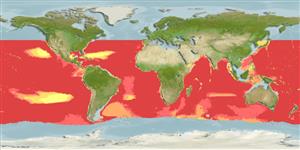Common names from other countries
>
Myctophiformes (Lanternfishes) >
Myctophidae (Lanternfishes) > Lampanyctinae
Etymology: Ceratoscopelus: Greek, keras, -atos = horn + Greek, skopelos = a lantern fish (Ref. 45335).
More on author: Lütken.
Environment: milieu / climate zone / depth range / distribution range
Ekologi
marina batypelagisk; havsvandrande (Ref. 51243); djupintervall 391 - 2056 m (Ref. 27311). Deep-water; 42°N - 65°S, 180°W - 180°E
Atlantic Ocean: 35°N (eastern limit) and 42°N (western limit) south to the Subtropical Convergence. Pacific Ocean: tropical and subtropical waters (Ref. 4066). Indian Ocean: 20°N-45°S (Ref. 4066). Reported to be common in southern Africa (Ref. 4066). South China Sea and East China Sea (Ref.74511).
Length at first maturity / Size / Vikt / Age
Maturity: Lm ?, range 5 - ? cm
Max length : 10.2 cm TL hane/ej könsbestämd; (Ref. 125989); publicerad maxvikt: 11.40 g (Ref. 125989)
Taggstrålar i ryggfenan (totalt) : 0; Mjukstrålar i ryggfenan (totalt) : 13 - 15; Taggstrålar i analfenan: 0; Mjukstrålar i analfenan: 13 - 15.
Oceanic species found between 700 and 1,500 m during the day; between 20 and 200 m at night (Ref. 4775) with maximum abundance between 50 and 100 m (Ref. 47377). Size stratification with depth both day and night (Ref. 4775). Small juveniles (1.5-1.9 cm) are apparently non-migratory. Known to feed on zooplankton but appears to be adapted for occasional herbivory (Ref. 28809).
Life cycle and mating behavior
Maturities | Reproduktion | Spawnings | Egg(s) | Fecundities | Larver
Hulley, P.A., 1990. Myctophidae. p. 398-467. In J.C. Quero, J.C. Hureau, C. Karrer, A. Post and L. Saldanha (eds.) Check-list of the fishes of the eastern tropical Atlantic (CLOFETA). JNICT, Lisbon; SEI; Paris; and UNESCO, Paris. Vol. 1. (Ref. 4479)
IUCN Red List Status (Ref. 130435)
CITES (Ref. 128078)
Not Evaluated
Threat to humans
Harmless
Human uses
Verktyg
Special reports
Download XML
Internet-källor
Estimates based on models
Preferred temperature (Ref.
115969): 3 - 8.8, mean 5.5 (based on 1535 cells).
Phylogenetic diversity index (Ref.
82804): PD
50 = 0.6250 [Uniqueness, from 0.5 = low to 2.0 = high].
Bayesian length-weight: a=0.00794 (0.00484 - 0.01305), b=3.20 (3.06 - 3.34), in cm Total Length, based on LWR estimates for this species & (Sub)family-body (Ref.
93245).
Trofisk nivå (Ref.
69278): 3.4 ±0.53 se; based on food items.
Resiliens (Ref.
120179): Hög, lägsta populationsfördubblingstid mindre än 15 månader (Preliminary K or Fecundity.).
Fishing Vulnerability (Ref.
59153): Low vulnerability (10 of 100).
